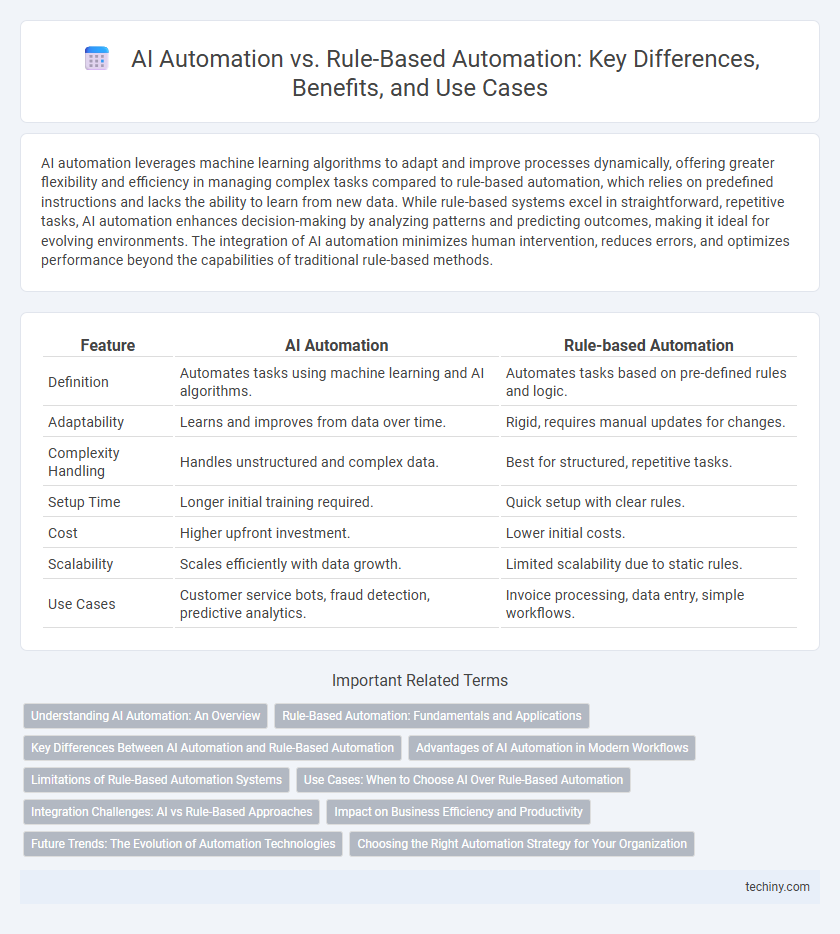AI automation leverages machine learning algorithms to adapt and improve processes dynamically, offering greater flexibility and efficiency in managing complex tasks compared to rule-based automation, which relies on predefined instructions and lacks the ability to learn from new data. While rule-based systems excel in straightforward, repetitive tasks, AI automation enhances decision-making by analyzing patterns and predicting outcomes, making it ideal for evolving environments. The integration of AI automation minimizes human intervention, reduces errors, and optimizes performance beyond the capabilities of traditional rule-based methods.
Table of Comparison
| Feature | AI Automation | Rule-based Automation |
|---|---|---|
| Definition | Automates tasks using machine learning and AI algorithms. | Automates tasks based on pre-defined rules and logic. |
| Adaptability | Learns and improves from data over time. | Rigid, requires manual updates for changes. |
| Complexity Handling | Handles unstructured and complex data. | Best for structured, repetitive tasks. |
| Setup Time | Longer initial training required. | Quick setup with clear rules. |
| Cost | Higher upfront investment. | Lower initial costs. |
| Scalability | Scales efficiently with data growth. | Limited scalability due to static rules. |
| Use Cases | Customer service bots, fraud detection, predictive analytics. | Invoice processing, data entry, simple workflows. |
Understanding AI Automation: An Overview
AI automation leverages machine learning algorithms and natural language processing to analyze data patterns and make intelligent decisions without explicit programming, enabling dynamic adaptation to complex tasks. Unlike rule-based automation, which follows predefined instructions rigidly, AI automation can learn from new data inputs and improve performance over time. This advanced capability enhances operational efficiency and supports scalable, flexible workflows across diverse industries.
Rule-Based Automation: Fundamentals and Applications
Rule-based automation operates on predefined instructions and logic, enabling systems to perform repetitive tasks with high accuracy and consistency. This approach excels in environments where processes are stable and predictable, such as invoice processing, data entry, and basic IT operations. Rule-based automation reduces human error and increases efficiency by strictly adhering to established business rules without the need for complex learning algorithms.
Key Differences Between AI Automation and Rule-Based Automation
AI automation leverages machine learning algorithms to adapt and improve processes based on data patterns, enabling dynamic decision-making across complex scenarios. Rule-based automation operates on predefined instructions and fixed logic, excelling in repetitive, structured tasks with limited variability. The key difference lies in AI automation's ability to handle unstructured data and evolve over time, whereas rule-based systems require manual updates for changes in workflows.
Advantages of AI Automation in Modern Workflows
AI automation leverages machine learning algorithms and natural language processing to adapt dynamically and improve decision-making, unlike rule-based automation which strictly follows predefined instructions. This adaptability enhances efficiency by enabling systems to handle complex tasks, recognize patterns, and learn from data in real time, reducing manual intervention. Integration of AI automation in modern workflows results in increased accuracy, scalability, and the ability to manage unstructured data, driving innovation and productivity.
Limitations of Rule-Based Automation Systems
Rule-based automation systems encounter limitations due to their rigid dependency on predefined rules, making them ineffective in handling complex or unstructured data. They lack adaptability, resulting in challenges when confronted with dynamic environments or evolving business processes. Furthermore, maintaining and updating extensive rule sets becomes resource-intensive, hindering scalability and reducing overall operational efficiency.
Use Cases: When to Choose AI Over Rule-Based Automation
AI automation excels in complex, unstructured environments such as customer service chatbots, fraud detection, and predictive maintenance where adaptability and learning from data are crucial. Rule-based automation is suited for repetitive, predictable tasks like invoice processing, data entry, and workflow approvals with predefined criteria. Choosing AI over rule-based automation is ideal when the task involves variability, natural language processing, or requires continuous improvement through machine learning models.
Integration Challenges: AI vs Rule-Based Approaches
AI automation faces complex integration challenges due to its reliance on machine learning models and continuous data inputs, which require dynamic adjustment of workflows and real-time data processing capabilities. In contrast, rule-based automation integrates more easily with existing systems by following predefined, static rules but often struggles with scalability and adaptability in changing environments. Enterprises must evaluate their infrastructure and data readiness to effectively implement AI automation while balancing simplicity and flexibility offered by rule-based systems.
Impact on Business Efficiency and Productivity
AI automation leverages machine learning and natural language processing to adapt and optimize processes in real-time, significantly enhancing business efficiency by reducing errors and accelerating decision-making. Rule-based automation follows predefined scripts that streamline repetitive tasks but lacks the flexibility to handle exceptions, potentially limiting productivity gains in dynamic environments. Integrating AI automation into workflows drives higher productivity through intelligent process optimization and continuous learning, while rule-based systems serve as foundational automation tools for stable, routine operations.
Future Trends: The Evolution of Automation Technologies
AI automation leverages machine learning algorithms and natural language processing to adapt and improve processes without human intervention, surpassing traditional rule-based automation that relies on static, predefined instructions. Future trends indicate a shift towards hybrid models combining AI's predictive analytics with rule-based systems for enhanced accuracy and efficiency across industries. Emerging technologies such as cognitive automation and autonomous decision-making will drive this evolution, enabling more sophisticated, context-aware automated workflows.
Choosing the Right Automation Strategy for Your Organization
AI automation leverages machine learning and natural language processing to adapt and improve processes autonomously, while rule-based automation relies on predefined instructions for repetitive tasks. Choosing the right automation strategy depends on your organization's complexity, scalability needs, and data availability, with AI automation suited for dynamic environments and rule-based systems ideal for straightforward, high-volume workflows. Evaluating long-term goals and integration capabilities ensures the selected approach enhances efficiency and drives innovation.
AI Automation vs Rule-based Automation Infographic

 techiny.com
techiny.com